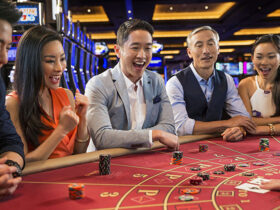Introduction:
Poker, often dubbed as a game of skill and strategy, demands a unique set of abilities from its players. While mastering the rules and understanding the odds are crucial, there’s an art that elevates a poker player’s game to the next level – the art of bluffing. In this article, we delve into the intricacies of mastering the poker face, an indispensable skill in the high-stakes world of poker.
Understanding the Poker Face:
The poker face, a stoic and unreadable expression, is the cornerstone of successful bluffing. To delve into its intricacies, one must first grasp the psychology behind it. The essence lies in presenting a demeanor that conceals any emotional tells, making it challenging for opponents to discern the strength or weakness of your hand.
Body:
- Maintaining Composure:
- Keeping emotions in check is pivotal to a successful poker face. Whether holding a strong hand or bluffing, maintaining composure prevents opponents from exploiting your reactions.
- Eye Contact and Gaze Control:
- The eyes are windows to the soul, and in poker, they reveal much. Mastering controlled eye contact and intentional gaze shifts can mislead opponents, adding an element of mystery to your gameplay.
- Body Language:
- Beyond the face, the entire body communicates. Learning to control body language, such as avoiding nervous ticks or subtle gestures, is essential. A relaxed and confident posture can project strength even when the cards say otherwise.
- Vocal Control:
- Verbal cues can betray a weak hand. Maintaining a steady tone, controlling pitch, and carefully choosing words contribute to an effective poker face. Silence can be just as powerful as speech in creating uncertainty.
- Timing is Key:
- The strategic use of pauses and deliberate delays can unnerve opponents. Timing the reveal of your cards or making decisions at unexpected moments can disrupt their ability to read your intentions accurately.
- Observing Opponents:
- While mastering your own poker face is crucial, observing opponents is equally important. Pay attention to their tells and use them to your advantage. However, be cautious not to rely solely on tells, as skilled players may intentionally mislead.
- Varying Your Strategy:
- Consistency is the enemy of a successful poker face. Intentionally mixing up your gameplay, alternating between aggressive and conservative moves, keeps opponents guessing and prevents them from predicting your actions.
Conclusion:
In the high-stakes arena of poker, the poker face is more than a mere expression – it’s a strategic tool. Mastering this art involves a combination of emotional control, body language manipulation, and strategic timing. By honing these skills, a player can ascend to new heights in the intricate dance of bluffs and bets. Remember, the poker face isn’t just about concealing your hand; it’s about making others reveal theirs.




